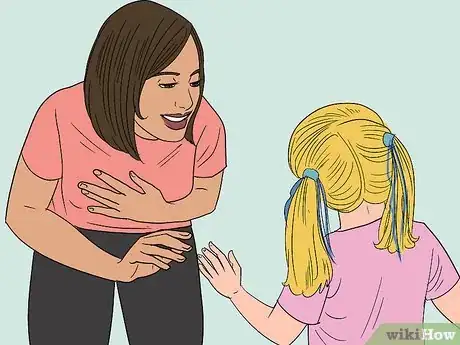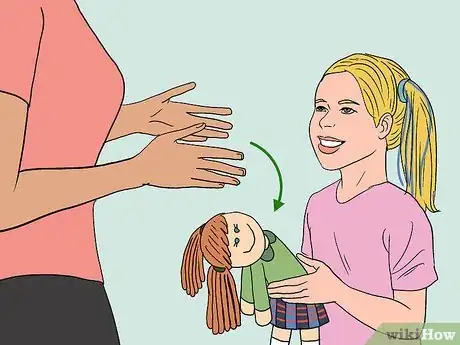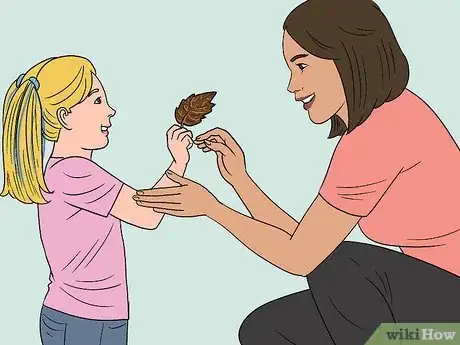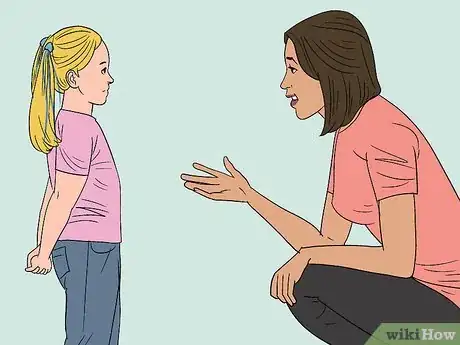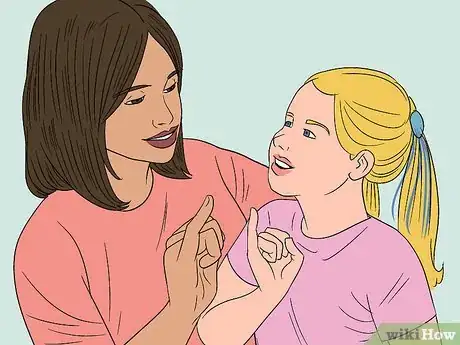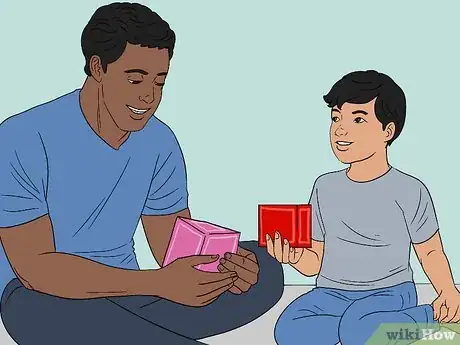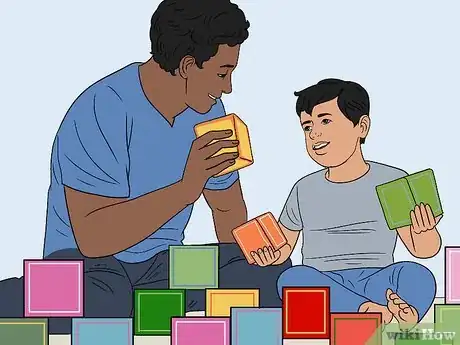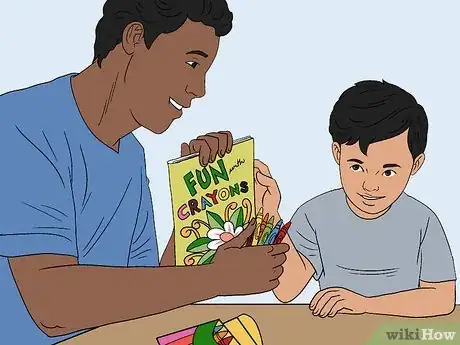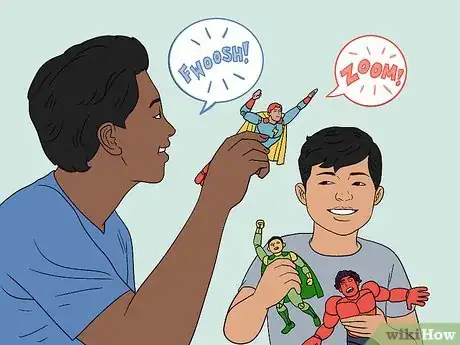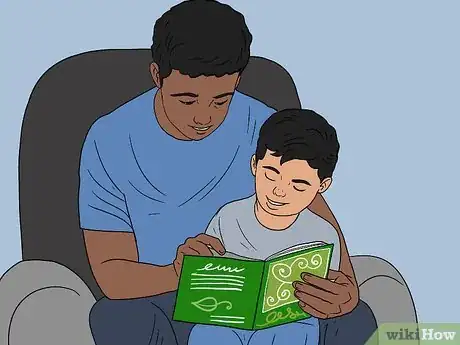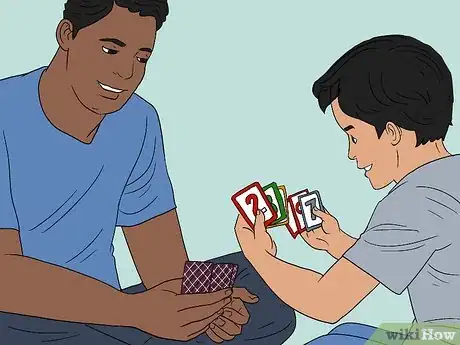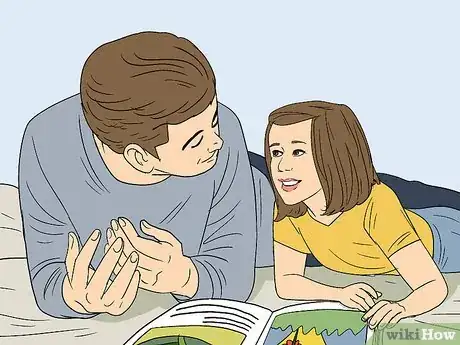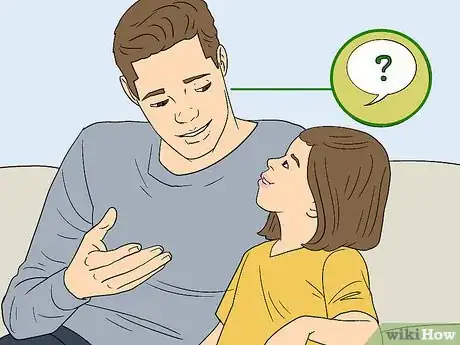This article was co-authored by Jessie Davidson and by wikiHow staff writer, Danielle Blinka, MA, MPA. Jessie Davidson is a Child Care Specialist and the CEO and Founder of BabysitPro, which provides online courses for current and aspiring babysitters. Jessie has over 20 years of childcare experience and specializes in best practices for sitters of infants, toddlers, preschoolers, and grade-schoolers. BabysitPro’s courses are unique and age-specific so babysitters can learn detailed information relevant to the children they babysit. Jessie holds a BA in French Studies from Wheaton College and an MA in Visual Anthropology from The University of Southern California.
There are 11 references cited in this article, which can be found at the bottom of the page.
wikiHow marks an article as reader-approved once it receives enough positive feedback. In this case, 100% of readers who voted found the article helpful, earning it our reader-approved status.
This article has been viewed 187,921 times.
Little kids are adorable, but they can also be intimidating. You might feel like you aren’t good with kids, especially if you haven’t spent a lot of time around them. Fortunately, there are several easy things you can do to quickly bond with a child and get them to enjoy spending time with you. No matter what role you play in a child’s life, you can win them over and get them to love you.
Steps
Bonding with the Child
-
1Maintain a smile and open body language so you’re not intimidating. Adults can seem super scary to kids, especially if they don’t know you well. Put the child at ease by showing them you're friendly. Smile at the child, keep your arms open, and angle your body toward them. When you need to talk to them directly, try to get down on their level.[1]
- If you seem closed off, the child might think you’re mean or don’t like them.
-
2Give the child a small gift or candy to win them over. A small trinket will probably make the child like you more right away. Choose something you think the child will enjoy. Show them the present right away so they warm up to you.[2]
- For example, you might bring something like a slinky, a mini box of legos, an inexpensive doll, a container of Play Dough, a coloring book, or a piece of candy.
- Check with the child’s parent before you give them a gift or candy to make sure it’s okay.
Advertisement -
3Share the child's excitement when they show you something. Little kids are excited about the world around them, so they’ll want to show you things like butterflies, leaves, or a new toy. Always display excitement and wonder when a child engages with you. You might even ask them follow-up questions.[3]
- If the child points out a big cloud, say, “Cool! What do you think the cloud looks like?”
- If the child hands you a leaf, you could say, “Thanks, buddy! This is a cool leaf!”
- If they have a new toy, you might say, “What does this toy do?” or “Are you having fun playing with it?”
-
4Give the child time to warm up to you if you've just met them. Don’t expect the child to engage with you immediately. On your first meeting, introduce yourself to them and offer a high-five or handshake to show you respect their boundaries. Then, ask their permission before touching them, giving them a hug, or picking them up.[4]
- You might ask, “Is it okay if I help you with your shoes?” “Can I help you with your coat?” or "Do you want a hug?"
- If the child doesn't want you to touch them, keep smiling at them and tell them it's okay. You could say something like, "I understand. Sometimes I don't want a hug, too."
-
5Show affection to the child when it’s appropriate. Being affectionate toward a child is important for bonding and can help you create happy memories together. When you’re first meeting a child, stick to handshakes, high fives, and fist bumps. Once you establish a relationship with them, they might feel ready to give you hugs. If you’re in a caregiving role, they may eventually like to cuddle while you’re reading or watching TV together. Follow the child’s lead when showing affection.[5]
- Little kids are very cute, so it's totally understandable that you want to hug them or pick them up. However, this can be scary to the child if they aren't used to you yet. Respect the child’s space and don’t try to force affection on them.
Playing with Small Children
-
1Focus all of your attention on the child while you’re playing with them. You likely have a lot on your mind, but try not to let that stop you from being fully present during playtime. Give the child your full attention for a set period of time, even if it’s just 15 minutes. Tap into your inner child and just enjoy playing.[6]
- If you’re babysitting the child, you might spend all of the time you’re with them playing.
- If you’re a parent, caregiver, or other adult, you might designate a set period of time for play. You could say, “I’m going to color with you for 30 minutes, but then I have to start dinner, or “Let’s play with your blocks for 15 minutes, then I need to go talk to your mommy.”
-
2Go with the flow instead of worrying about rules. As an adult, you likely want to bring structure to games and activities. However, little kids are still learning and enjoy exploring. If you try to show them the “right way” to do something, they’ll likely get frustrated and might shut down. Instead, let them lead the way and be open to playing their way.[7]
- Let’s say you’re building with Legos or blocks. You might be tempted to show the child how to make a sturdy foundation or how to follow instructions to make cool projects. Instead, let the child experiment with the blocks.
- Similarly, let’s say you’re coloring with the child. It’s okay if they want to scribble outside the lines.
-
3Suggest fun activities you know the child will like. Kids may get more excited about playing with you if you seem interested in the activity. Instead of waiting for the child to ask you to play, bring up activities you think they might like. Ask them if they’d want to play with you.[8]
- You might say, “I heard you’re great at coloring. Could you show me how to make pretty pictures?” or “It’s been a long time since I’ve gotten to build something with blocks. Do you think we could play with yours together?”
- If you have the space or can use some outdoor space, build an obstacle course. Get creative and use whatever supplies you have to hand.
-
4Act silly or funny when you’re playing together. Kids will feel more comfortable around you if you seem child-like. When you’re playing one-on-one with them, try not to be serious. Make silly voices and sounds, act goofy, and see if you can make the child laugh. If they’re having fun, they’ll enjoy spending time with you.[9]
- If you’re playing with dolls, plushies, or action figures, pick them up and make them “talk” with goofy voices.
- If you’re making things with clay or Play Dough, you might make fart sounds or other sound effects when you squish or shape the dough.
-
5Play make-believe to keep the child engaged. Kids have active imaginations, so be willing to think outside the box when it comes to play. Suggest make believe games based on what you know about the child. Then, make up a story to guide your playtime.[10]
- You might suggest make-believe scenarios like superheroes, pirates, or spaceship.
- If you were playing superheroes, you might ask the child where the bad guy is. Then, come up with your gadgets and super powers. Pretend you’re doing things like fighting bad guys or flying around.
- Build the ultimate fort. Use blankets, pillows, sheets and cushions to make a soft, cozy and safe fort. Have the kids suggest what shape or style of fort they'd like. Then you can encourage them to play make-believe games using the fort.
-
6Read to the child when they want to do a quiet activity. Reading is fun and helps with learning. Ask the child to pick their favorite story book or offer them choices that are appropriate for their age range. As you read, use fun voices for the characters, talk slowly, and make facial expressions that go along with the story.[11]
- You can also tell stories with finger puppets or props if you want to make storytime more exciting.
- Involve the child in the story by asking them what they think happens next.
- If the child can’t sit still through the whole story, set the book aside and let them come back to it if they want to start reading again.
-
7Use games to encourage interactive play. Pick a game that’s age appropriate for the child. For toddlers, you might put together a puzzle, play hide-and-seek, or play Simon Says. If the children are preschool or kindergarten age, you can try playing simple board games or card games with them.[12]
- Don’t worry as much about the rules while you’re playing the game with the child. You might gently remind them of rules when they break them, but try to just have fun.
- If you’re outdoors, try playing tag, drawing with chalk, or kicking a ball around.
- Make chores and clean-up a fun game to play. For example, you may say, “I bet you can’t clean up all of your toys in 1 minute.”
- Make up your own card game. With the help of the child or children, assign an activity to each suit, like hearts as jumping jacks and diamonds as making funny faces. Upon each draw of a card from the pack, the child has to perform the fun task the card requires. For example, if you draw the 6 of hearts, you must do 6 jumping jacks!
Talking to the Child
-
1Make eye contact with the child when you’re talking or listening to them. Meeting a child’s eyes shows respect and care for them. Additionally, it helps you create a connection with them that encourages them to like you more. Look kids in the eye if you’re telling them something or asking them a question. When they’re talking to you, make eye contact to show you’re listening.[13]
- You don’t have to make sustained eye contact. It’s okay to shift your eyes away for a few seconds at a time.
- Consider getting down on the child’s level to make it easier to make eye contact. If you’re towering over them, the child could feel intimidated.
-
2Use normal speech instead of baby talk in regular conversations. You might be tempted to imitate how a toddler or young child speaks, but they can perceive this as talking down to them. Instead, use a kind tone and stick to short sentences that are easier for the child to follow. If you think they don’t understand, repeat what you said in a different way.[14]
- It's okay to use silly voices and baby talk to entertain the child during play.
- Very young children may like baby talk. Pay attention to how other adults talk to the child to see if baby talk may work with them.
- Not only will this show the child you respect them, it might also help their verbal skills.
-
3Ask the child questions to show you’re interested in them. Children feel special when they know you care about their interests and activities. Choose 2 to 3 simple questions you can ask the child. Then, really listen to their answers. If you have follow-up questions, go ahead and ask those as well.[15]
- You might ask questions like, “What’s your favorite part of Frozen?” “What are you building with your blocks?” or “What did you find on your walk today?”
- Raise the pitch of your voice when you reach the end of a question so the child recognizes when it’s time to respond.
- Don’t pepper the child with questions because they might get overwhelmed. Instead, stick to a few specific questions you think they can answer.
-
4Listen with enthusiasm when they tell you about what they like. It’s totally normal for kids to ramble on when they talk to you, and it’s okay to feel frustrated when this happens. However, it’s important to stay excited and nod along so the child knows you care about them. They’re sharing something important with you, so smile, nod, and give interested responses, like “Wow,” or “Cool!”[16]
- Try not to interrupt the child while they’re talking. It’s okay to make little comments like, “That must be exciting” or “What happened next?” to show you’re following along.
- Don’t use your phone while you’re listening to the child. Always give them your full attention.
-
5Praise the child for good behavior and small accomplishments. Little kids want to know you value and appreciate them, especially when they try hard at things. Be generous with praise so the child feels encouraged and loved. Look for opportunities to dish out a compliment.[17]
- Give them compliments like, “Wow! Great job stacking your blocks!” “Good job coloring!” or “Great job putting your toys up!”
- Even if the child did something you don’t want them to do, you can still praise them as long as you give them a warning, too. For example, you could say, “I love that you practiced drawing, but let’s try it on paper instead of the wall this time.”
Community Q&A
Did you know you can get answers researched by wikiHow Staff?
Unlock staff-researched answers by supporting wikiHow
-
QuestionHow do you make a kid love you?
 wikiHow Staff EditorThis answer was written by one of our trained team of researchers who validated it for accuracy and comprehensiveness.
wikiHow Staff EditorThis answer was written by one of our trained team of researchers who validated it for accuracy and comprehensiveness.
Staff Answer wikiHow Staff EditorStaff AnswerDon’t try to force it! You can’t really make anyone love you—and that includes both kids and adults. However, a kid is more likely to love you if you treat them with kindness and respect. Be reliable, so they know they can trust you. Be there for them when they need you, do your best to be patient with them, and talk to them about things they find interesting.
wikiHow Staff EditorStaff AnswerDon’t try to force it! You can’t really make anyone love you—and that includes both kids and adults. However, a kid is more likely to love you if you treat them with kindness and respect. Be reliable, so they know they can trust you. Be there for them when they need you, do your best to be patient with them, and talk to them about things they find interesting. -
QuestionHow do I show my daughter I love her?
 wikiHow Staff EditorThis answer was written by one of our trained team of researchers who validated it for accuracy and comprehensiveness.
wikiHow Staff EditorThis answer was written by one of our trained team of researchers who validated it for accuracy and comprehensiveness.
Staff Answer wikiHow Staff EditorStaff AnswerThere are lots of ways to show love to your child. One of the most obvious ones is to tell her you love her, but you can also tell her about specific ways that you appreciate her—for example, “I love how curious and creative you are!” or “Thanks so much for all your help today, you’re being so responsible.” You can also show love by doing things for her (like doing fun activities or getting her things that she wants or needs) or using affectionate touches, like a hug or a pat on the back.
wikiHow Staff EditorStaff AnswerThere are lots of ways to show love to your child. One of the most obvious ones is to tell her you love her, but you can also tell her about specific ways that you appreciate her—for example, “I love how curious and creative you are!” or “Thanks so much for all your help today, you’re being so responsible.” You can also show love by doing things for her (like doing fun activities or getting her things that she wants or needs) or using affectionate touches, like a hug or a pat on the back. -
QuestionHow do you know if you are good with kids?
 wikiHow Staff EditorThis answer was written by one of our trained team of researchers who validated it for accuracy and comprehensiveness.
wikiHow Staff EditorThis answer was written by one of our trained team of researchers who validated it for accuracy and comprehensiveness.
Staff Answer wikiHow Staff EditorStaff Answer
wikiHow Staff EditorStaff Answer
Warnings
- Don’t give too many gifts to the child since they may think that you’ll always bring something for them.⧼thumbs_response⧽
- Try not to raise your voice around little kids because they may get scared.⧼thumbs_response⧽
References
- ↑ https://www.helpguide.org/articles/parenting-family/what-is-secure-attachment-and-bonding.htm
- ↑ https://www.youtube.com/watch?v=u6mVSWrjUv8&feature=youtu.be&t=57
- ↑ https://greatergood.berkeley.edu/article/item/with_kids_love_is_in_the_little_things
- ↑ https://www.youtube.com/watch?v=3NeDodgqBXI&feature=youtu.be&t=157
- ↑ https://www.helpguide.org/articles/parenting-family/what-is-secure-attachment-and-bonding.htm
- ↑ https://raisingchildren.net.au/toddlers/connecting-communicating/connecting/positive-attention
- ↑ https://www.zerotothree.org/resources/1081-tips-on-playing-with-babies-and-toddlers
- ↑ https://greatergood.berkeley.edu/article/item/with_kids_love_is_in_the_little_things
- ↑ https://www.zerotothree.org/resources/1081-tips-on-playing-with-babies-and-toddlers
- ↑ https://raisingchildren.net.au/toddlers/connecting-communicating/connecting/connecting-with-your-toddler
- ↑ https://kidshealth.org/en/parents/reading-toddler.html
- ↑ https://www.todaysparent.com/toddler/20-fun-indoor-games/
- ↑ https://www.helpguide.org/articles/parenting-family/what-is-secure-attachment-and-bonding.htm
- ↑ https://www.theguardian.com/lifeandstyle/2016/jan/30/how-to-talk-to-children-even-if-you-dont-have-any
- ↑ https://www.parents.com/parenting/better-parenting/advice/6-small-ways-to-make-each-of-your-kids-feel-special/
- ↑ https://www.parents.com/parenting/better-parenting/advice/6-small-ways-to-make-each-of-your-kids-feel-special/
- ↑ https://raisingchildren.net.au/toddlers/connecting-communicating/connecting/connecting-with-your-toddler
About This Article
If you want to be loved by little kids, listen to them closely when they speak and ask them questions to encourage them to open up to you. For example, if they tell you they like fruit, ask them a question like, “Do you like apples or bananas more?” to engage them. If you’re meeting a child for the first time, you might bring them a small gift or toy to play with together. If you don’t have any toys to play with, you can play make-believe for fun! Kids have an active imagination, so ask them what they want to do, whether that’s riding in a spaceship or playing house. Listen as they make up what’s happening and respond with sound effects, gestures, and movements that match the scene. To learn how to choose activities based on a child’s age, read on!
